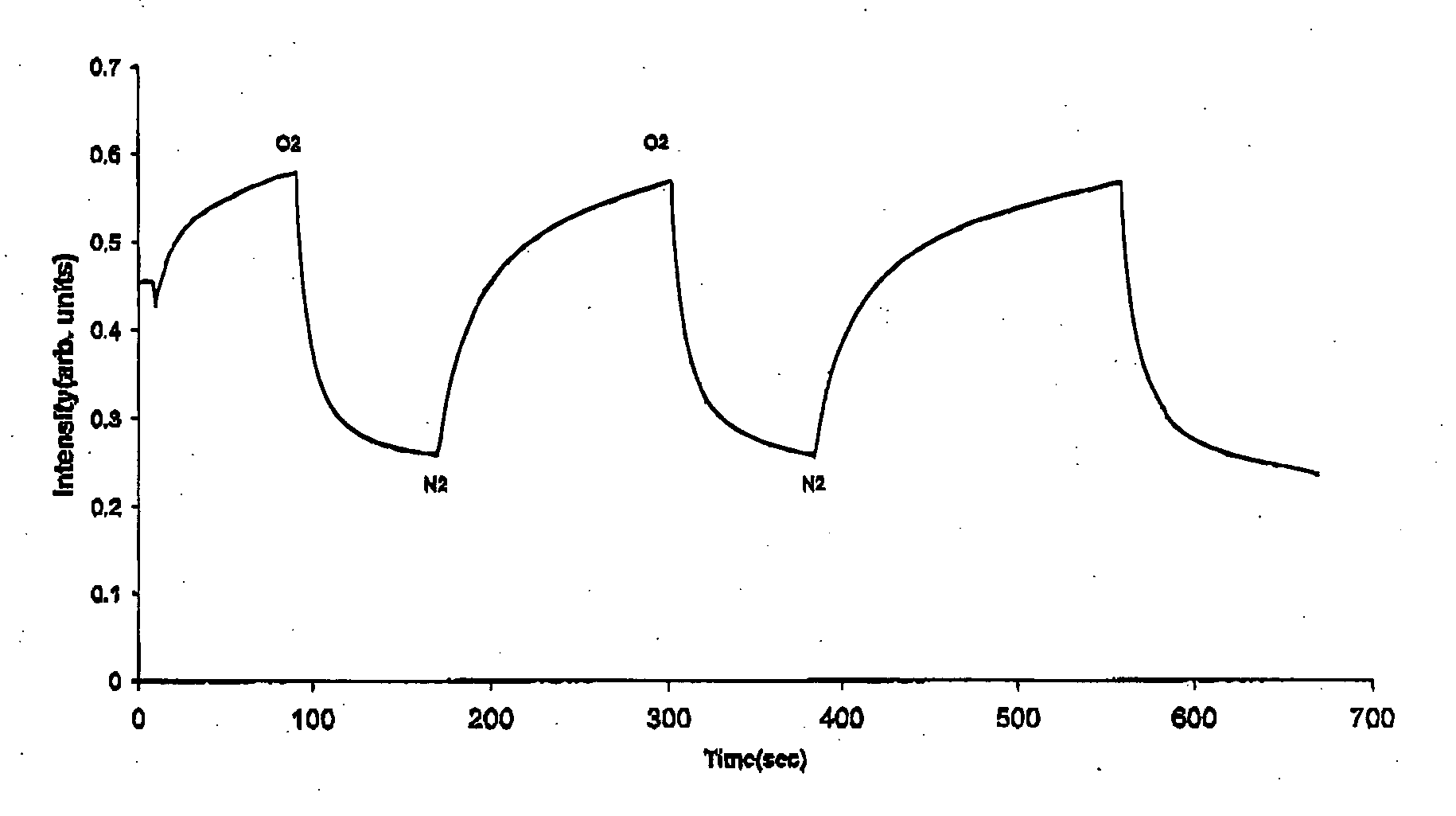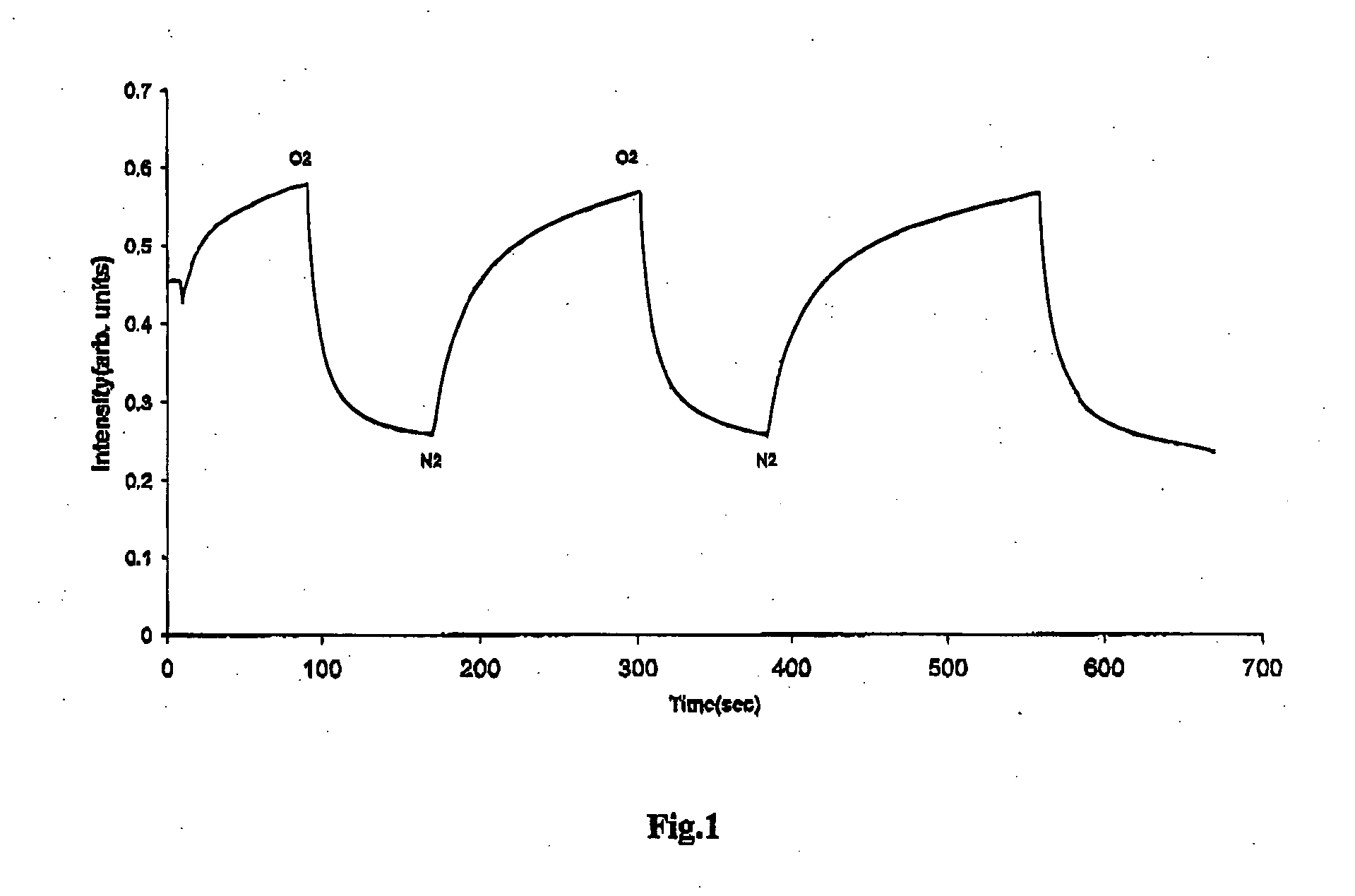Electrochemical luminescence composite material with anti-biofouling properties
a technology of electrochemical luminescence and composite materials, applied in the field of electrochemical luminescent composite materials with anti-biofouling properties, can solve the problems of sensor dysfunction, lack of long-term stability, and insufficient stability of immobilized luminescent materials
- Summary
- Abstract
- Description
- Claims
- Application Information
AI Technical Summary
Benefits of technology
Problems solved by technology
Method used
Image
Examples
example 1
[0016] First, dissolve the following momomers: 30 grams of MPC, 68 grams of butyl methacrylate, 2 grams of γ-methacryloxypropyl triethoxysilane and 0.1 gram of azobisisobutyronitrile (AIBN) as initiator into 200 ml ethanol. Bubble the solution with argon for 1 hour to eliminate oxygen. Then heat the solution to 70° C. with a thermostated bath, react under magnetic stirring for 24 hours. After that, cool the solution to room temperature, precipitate in an excess amount of hexane. After drying, the precipitate is dissolve in ethanol and precipitate in hexane again. The final precipitate is collected and dried in vacuum for 24 hours at room temperature. 90 grams of phosphorylcholine containing polymer can be thus obtained.
[0017] Dissolve 0.1 gram of a hydrophobic ruthenium complex, tris(4,7-diphenyl-1,10-phenanthroline)-ruthenium (II) bis(hexafluorophosphate) into 10 ml methane, put 0.8 gram of the above mentioned phosphorylcholine containing polymer into the same solution, magnetical...
example 2
[0018] First, dissolve the following momomers: 15 grams of MPC, 10 grams of poly(ethylene glycol)methyl ether methacrylate (M=360), 10 grams of ethylene glycol methyl ether methacrylate, 63 grams of dodecyl methacrylate, 2 grams of γ-methacryloxypropyl trimethoxysilane and 0.1 gram of AIBN as initiator into ethanol / THF mixed solvent (50 / 50, v / v). Bubble the solution with argon for 1 hour to eliminate oxygen. Then heat the solution to 70° C. with a thermostated bath, react under magnetic sting for 24 hours. After that, cool the solution to room temperature, precipitate in an excess amount of hexane. After drying, the precipitate is dissolve in ethanol / THF and precipitate in hexane again. The final precipitate is collected and dried in vacuum for 24 hours at room temperature, 92 grams of phosphorylcholine containing polymer can be thus obtained.
[0019] Mix together the following reagents, 1 ml tetraethoxysilane (TEOS), 0.2 ml water, 20 μl of 0.1 mol / l hydrochloric acid aqueous solutio...
example 3
[0021] First, dissolve the following momomers: 20 grams of MPC, 8 grams of N-vinyl pyrrolidone, 5 grams of β-hydroxyethyl methacrylate, 67 grams of butyl acrylate, and 0.1 gram of AIBN as initiator into ethanol / THF mixed solvent (50 / 50, v / v). Bubble the solution with argon for 1 hour to eliminate oxygen Then heat the solution to 75° C. with a thermostated bath, react under magnetic stirring for 24 hours. After that, cool the solution to room temperature, precipitate in an excess amount of hexane. After drying, the precipitate is dissolve in ethanol / THF and precipitate in hexane again. The final precipitate is collected and dried in vacuum for 24 hours at room temperature. 89 grams of phosphorylcholine containing polymer can be thus obtained.
[0022] Dissolve 1 gram of the phosphorylcholine containing polymer in this example in 10 ml of THF, then stir thoroughly after put 80 mg of 2,6-di-O-isobutyl-β-cyclodextrin (DOB-β-CD) and 20 mg of meso-tetra(4-methoxylphenyl)porphyrin (TMOPP) in...
PUM
| Property | Measurement | Unit |
|---|---|---|
| thick | aaaaa | aaaaa |
| electrochemical | aaaaa | aaaaa |
| anti-biofouling electrochemical luminescent | aaaaa | aaaaa |
Abstract
Description
Claims
Application Information
 Login to View More
Login to View More - R&D
- Intellectual Property
- Life Sciences
- Materials
- Tech Scout
- Unparalleled Data Quality
- Higher Quality Content
- 60% Fewer Hallucinations
Browse by: Latest US Patents, China's latest patents, Technical Efficacy Thesaurus, Application Domain, Technology Topic, Popular Technical Reports.
© 2025 PatSnap. All rights reserved.Legal|Privacy policy|Modern Slavery Act Transparency Statement|Sitemap|About US| Contact US: help@patsnap.com


